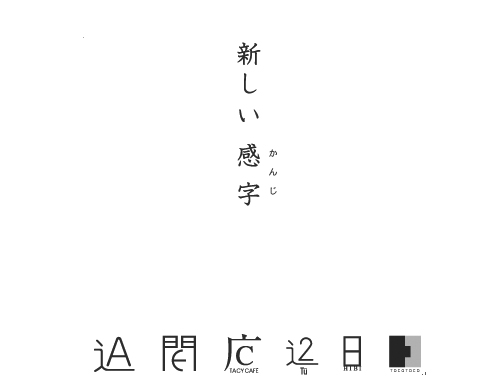新しい感字 | New Kanji Feeling Character

新しい感字
Communication(伝達─通信)からConsensus(合意、一致、共通理解)へ
Consensus 前形─ラテン 同意、共通理解
語源─Con(共に) Sentire(感じる)
わたしたちの言葉のあゆみ
日本語とは何だろう。
他民族に例を見ないこの独自の言語は、漢字を中国から輸入し、そこから日本オリジナルのカタカナとひらがなを開発。さらには、西洋のアルファベットを取り入れてローマ字表記体系まで作りました。
日本人というのは、そもそもその言語の成り立ちから、何かを外から取り入れ、それをもとにまったく新しい別のものを作りだすという行為をしているのです。
そして現代、国際化が進み、まだ英語を完璧に話せる日本人は少ない現状の中でも、街には英語をはじめとした西洋の言葉が溢れ、私たちの普段の会話のなかにもごく自然に横文字の単語が溶けこみ、純粋に日本語だけで話すことの方が難しく感じてしまうほどです。
かつて漢字からカタカナやひらがなを作り出したように、今、ふたたび新たな日本の文字を生み出し、理解することができるのでは?
西洋─東洋というかけはなれた文化を融合し、そこから新しい何かを作りだすのに最も適しているのは日本人ではないか?
そんな思いから、1995年に漢字とアルファベットを組み合わせた「新しい感字」という表現を考案しました。
私たちが現在使っている「漢字」を英訳するとChinese character。
「感字」を訳すならば[Feeling character]でしょうか。
New Kanji
Feeling Character
From Communication to Consensus
Consensus from Latin, ¨agreement¨ ¨harmony¨
The origin- Con (prefix) ¨together¨ + sensus ¨sense¨
The history of Japanese language
What is Japanese language?
This elusive Japanese language imported Chinese characters (kanji) to invent hiragana-alphabet.
This soon developed into the katakana-alphabet for the purpose of describing words of the other language.
Furthermore, Japanese also write Roma-ji, using the English alphabet when conveying Japanese pronunciations.
Now there is a possibility to mix the Western and The Eastern letters to develop new characters, as our ancestors did.
Hamiru invented new characters, called ¨Feeling Character¨ in 1995 by means of combination of Chinese characters and the alphabets.
1995-